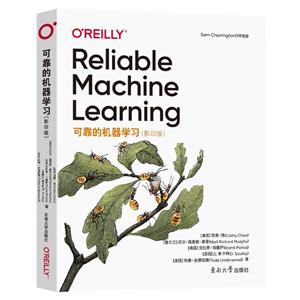中圖網小程序
一鍵登錄
更方便
本類五星書更多>
-
>
全國計算機等級考試最新真考題庫模擬考場及詳解·二級MSOffice高級應用
-
>
決戰行測5000題(言語理解與表達)
-
>
軟件性能測試.分析與調優實踐之路
-
>
第一行代碼Android
-
>
JAVA持續交付
-
>
EXCEL最強教科書(完全版)(全彩印刷)
-
>
深度學習
可靠的機器學習(影印版) 版權信息
- ISBN:9787576605525
- 條形碼:9787576605525 ; 978-7-5766-0552-5
- 裝幀:一般膠版紙
- 冊數:暫無
- 重量:暫無
- 所屬分類:>
可靠的機器學習(影印版) 內容簡介
無論你是小型創業公司或跨國公司的一員,這本實踐用書為數據科學家、軟件和網站可靠性工程師、產品經理和企業主展示了如何在組織內可靠、有效和負責地運行和建立機器學習。你將深入了解其中涉及的方方面面,從如何在生產中進行模型監控到如何在產品組織中運營一個完善的模型開發團隊。通過將SRE思維應用于機器學習,作為本書作者和工程專業人士的Cathy Chen、Kranti Parisa、Niall、D. Sculley、Todd Underwood以及特邀作者向你展示了如何運行高效可靠的機器學習系統。無論你想增加收入、優化決策、解決問題,還是理解和影響客戶行為,你將學習如何執行日常的機器學習任務,同時保持更廣闊的視野。
可靠的機器學習(影印版) 目錄
Foreword
Preface
1. Introduction
The ML Lifecycle
Data Collection and Analysis
ML Training Pipelines
Build and Validate Applications
Quality and Performance Evaluation
Defining and Measuring SLOs
Launch
Monitoring and Feedback Loops
Lessons from the Loop
2. Data Management Principles
Data as Liability
The Data Sensitivity of ML Pipelines
Phases of Data
Creation
Ingestion
Processing
Storage
Management
Analysis and Visualization
Data Reliability
Durability
Consistency
Version Control
Performance
Availability
Data Integrity
Security
Privacy
Policy and Compliance
Conclusion
3. Basic Introduction to Models
What Is a Model?
A Basic Model Creation Work_flow
Model Architecture Versus Model Definition Versus Trained Model
Where Are the Vulnerabilities?
Training Data
Labels
Training Methods
Infrastructure and Pipelines
Platforms
Feature Generation
Upgrades and Fixes
A Set of Useful Questions to Ask About Any Model
An Example ML System
Yarn Product Click-Prediction Model
Features
Labels for Features
Model Updating
Model Serving
Common Failures
Conclusion
4. Feature and Training Data
Features
Feature Selection and Engineering
Lifecycle of a Feature
Feature Systems
Labels
Human-Generated Labels
Annotation Workforces
Measuring Human Annotation Quality
……
5. Evaluating Model Validity and Quality
6. Fairness, Privacy, and Ethical ML Systems
7. Training Systems
8. Serving
9. Monitoring and Observability for Models
10. Continuous ML
11. Incident Response
12. How Product and ML Interact
13. Integrating ML into Your Organization
14. Practical ML Org Implementation Examples
15. Case Studies: MLOps in Practice
Index
Preface
1. Introduction
The ML Lifecycle
Data Collection and Analysis
ML Training Pipelines
Build and Validate Applications
Quality and Performance Evaluation
Defining and Measuring SLOs
Launch
Monitoring and Feedback Loops
Lessons from the Loop
2. Data Management Principles
Data as Liability
The Data Sensitivity of ML Pipelines
Phases of Data
Creation
Ingestion
Processing
Storage
Management
Analysis and Visualization
Data Reliability
Durability
Consistency
Version Control
Performance
Availability
Data Integrity
Security
Privacy
Policy and Compliance
Conclusion
3. Basic Introduction to Models
What Is a Model?
A Basic Model Creation Work_flow
Model Architecture Versus Model Definition Versus Trained Model
Where Are the Vulnerabilities?
Training Data
Labels
Training Methods
Infrastructure and Pipelines
Platforms
Feature Generation
Upgrades and Fixes
A Set of Useful Questions to Ask About Any Model
An Example ML System
Yarn Product Click-Prediction Model
Features
Labels for Features
Model Updating
Model Serving
Common Failures
Conclusion
4. Feature and Training Data
Features
Feature Selection and Engineering
Lifecycle of a Feature
Feature Systems
Labels
Human-Generated Labels
Annotation Workforces
Measuring Human Annotation Quality
……
5. Evaluating Model Validity and Quality
6. Fairness, Privacy, and Ethical ML Systems
7. Training Systems
8. Serving
9. Monitoring and Observability for Models
10. Continuous ML
11. Incident Response
12. How Product and ML Interact
13. Integrating ML into Your Organization
14. Practical ML Org Implementation Examples
15. Case Studies: MLOps in Practice
Index
展開全部
可靠的機器學習(影印版) 作者簡介
凱茜·陳(Cathy Chen)曾在Google擔任技術項目經理、產品經理和工程經理。
書友推薦
- >
自卑與超越
- >
中國歷史的瞬間
- >
巴金-再思錄
- >
企鵝口袋書系列·偉大的思想20:論自然選擇(英漢雙語)
- >
新文學天穹兩巨星--魯迅與胡適/紅燭學術叢書(紅燭學術叢書)
- >
月亮虎
- >
我從未如此眷戀人間
- >
山海經
本類暢銷















